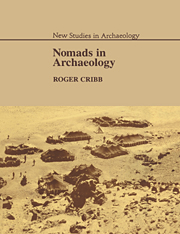Book contents
- Frontmatter
- Contents
- List of illustrations
- List of tables
- Preface
- 1 Introduction
- 2 Origins and definitions
- 3 Nomad pastoral economy
- 4 Residence, descent and territory
- 5 Nomads – the invisible culture?
- 6 Nomad architecture and domestic space
- 7 Ali's camp: a nomad household campsite
- 8 The structure and location of nomad settlements
- 9 Sariaydin Yayla
- 10 The lost world of Nemrut Daḡ
- 11 Nomad archaeology: an assessment
- 12 Towards a model of unstable settlement systems
- References
- Glossary
- Index
Preface
Published online by Cambridge University Press: 23 September 2009
- Frontmatter
- Contents
- List of illustrations
- List of tables
- Preface
- 1 Introduction
- 2 Origins and definitions
- 3 Nomad pastoral economy
- 4 Residence, descent and territory
- 5 Nomads – the invisible culture?
- 6 Nomad architecture and domestic space
- 7 Ali's camp: a nomad household campsite
- 8 The structure and location of nomad settlements
- 9 Sariaydin Yayla
- 10 The lost world of Nemrut Daḡ
- 11 Nomad archaeology: an assessment
- 12 Towards a model of unstable settlement systems
- References
- Glossary
- Index
Summary
The convergence of three long-standing interests – a fascination with Anatolia, the phenomenon of nomadism and commitment to the progress of analytical archaeology – have come together in producing this book. Scattered observations during travels in Iran and Turkey during the mid-1970s had convinced me that pastoral campsites provided an ideal laboratory in which to pursue certain strands of emerging middle range theory, particularly with respect to occupation floor models and site structure.
What might have been a detailed empirical study, carried out under controlled conditions in carefully selected sites, changed direction in the field. Confronted with the realities of ethnoarchaeological research in the modern Near East, I was not only forced to be more eclectic in terms of the campsites studied, but was also encouraged to diversify, taking an interest in Seljuk history and local history, ruined caravanserais and the accounts of nineteenth-century travellers, together with neo-Marxist anthropology and quantitative techniques of spatial analysis. While I had planned for a more in-depth coverage of a single region or group of nomads, there were compensations in the form of greater geographical range and diversity in the nomadic and semi-nomadic groups visited.
The beginning of my ethnoarchaeological fieldwork coincided to the day with the October 12 military coup in 1980 which put certain constraints on my activities. Yet compared with other countries in the region, conditions in Turkey were quite favourable.
- Type
- Chapter
- Information
- Nomads in Archaeology , pp. xiii - xivPublisher: Cambridge University PressPrint publication year: 1991

